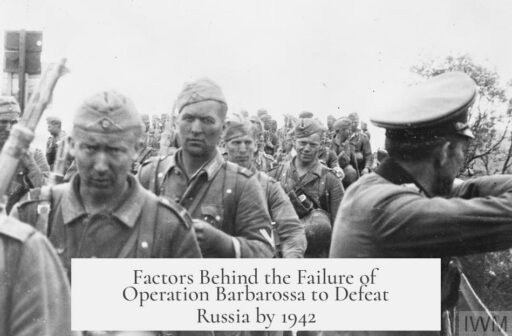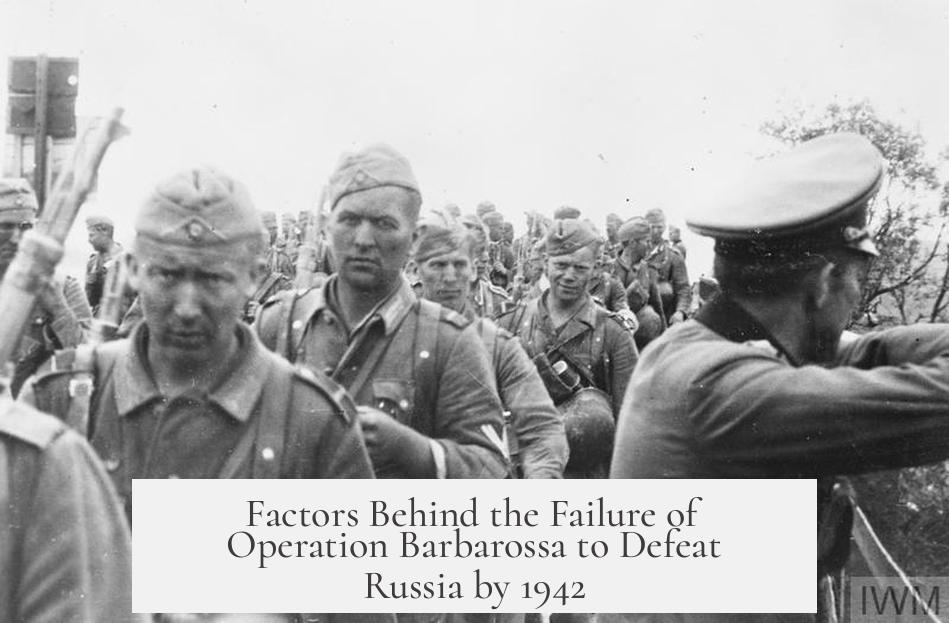Operation Barbarossa failed to defeat Russia by 1942 due to a mix of logistical challenges, tactical misjudgments, strategic errors, and Soviet resilience. The German advance stalled as supply lines stretched beyond capacity. Harsh weather and terrain conditions favored the defending Soviets. Additionally, Soviet military adaptability and vast resources countered German plans.
Initially, the German invasion began too late in 1941 to reach Moscow before winter. This delay exposed troops to extreme cold for which they lacked proper equipment. The onset of the Russian winter, combined with rainy seasons, turned roads into mud, further slowing German movements. The overstretched supply lines could not deliver essential fuel and ammunition rapidly enough to frontline units. These supply difficulties capped German operational reach near Moscow by late 1941.
The Germans also underestimated Soviet armored forces. Soviet T-34 tanks featured a long-barreled 75 mm gun superior in firepower and armor to German Panzer III and IV models. By the invasion date, the Red Army possessed nearly 1,000 T-34s and over 500 KV tanks. German forces ignored their significance, pressing forward as if these powerful vehicles did not exist. This oversight contributed to costly Soviet resistance at battles like Stalingrad, where Soviet tanks blunted German advances and caused severe losses.
The Soviet command structure proved resilient and flexible. Unlike typical European armies, the Red Army embedded deputy commanders within divisions. This allowed units to rebuild or reorganize quickly during combat or mobilization. The Germans underestimated this system’s efficiency, which enabled Soviet forces to recover rapidly from defeats and field fresh troops repeatedly. The Soviet military also included large numbers of dedicated personnel willing to fight regardless of casualties.
Geographically, the Soviet Union’s vastness worked as a natural defense. Its immense size complicated German logistics and forced overstretched supply networks. Furthermore, the USSR’s substantial natural resources and industrial base enabled ongoing rearmament and replacement of losses. Soviet tank and weapon production outpaced German capacity during much of the war. The USSR also received foreign aid through programs like Lend-Lease, helping maintain material strength.
Nazi racial ideology harmed German objectives by alienating many potential local allies. Although some ethnic groups within Soviet territory welcomed Germans as liberators from Stalinist rule, Nazi policies promoted racist views toward Slavs and treated civilians harshly. This brutal approach pushed many locals into supporting Soviet partisans, tying down German troops on internal security. Rather than gaining local reinforcements, German forces had to dedicate thousands of soldiers to anti-partisan operations.
The Soviet population’s morale hardened under Nazi atrocities. Earlier Soviet policies had caused hardships, such as the 1930s Holodomor famine in Ukraine. Yet, Nazi brutality united many previously indifferent Soviet citizens behind Stalin and the war effort. The desire to resist to the last person grew as German massacres became known. This resolve contrasted with German expectations that harsh treatment would collapse Soviet resistance quickly.
German strategic decisions further compounded difficulties. Hitler’s micro-management often overrode experienced commanders’ advice, leading to inflexible tactics and failure to retreat when necessary. Tactical rigidness combined with supply shortages amplified German losses. Other campaigns diverted attention and resources. For example, the need to assist Italy after its invasion of Greece delayed Barbarossa by about a month, reducing Germany’s chances of a swift victory before winter.
Soviet military inclusiveness also helped. Women served as combatants and support personnel, swelling available manpower beyond German estimates. The prolonged siege of Leningrad tied up significant German forces, preventing them from reinforcing other fronts. Soviet leaders trusted their generals, allowing coordinated operations across wide fronts rather than centralized, inflexible control like Hitler’s.
In essence, the Soviet Union’s advantages—size, population, industrial capacity, and flexible military command—overcame the initial shock of Barbarossa. The combination of weather, logistical strain, stronger Soviet armor, and ideological misjudgments by Nazi Germany stopped the invasion by early 1942. The conflict then turned into a prolonged war of attrition unfavorable to Germany.
| Key Reasons for Barbarossa’s Failure to Defeat Russia by 1942 |
|---|
| Logistics & Environment: Overextended supply lines; harsh winter; muddy roads |
| Tactics & Technology: Underestimation of T-34 tanks; Red Army’s robust command; superior resupply |
| Strategic & Political: Vast Soviet territory; abundant resources; Nazi racial policies alienated locals |
| Military Leadership: Hitler’s interference; inflexible tactics; Soviet resilience and staff inclusiveness |
- Operation Barbarossa stalled largely due to logistical failures and environmental challenges.
- German underestimation of Soviet armor and command adaptability allowed Red Army recovery.
- Nazi racial and political policies reduced local cooperation, increasing partisan resistance.
- The USSR’s size, resources, and population provided a decisive advantage over Germany.
- Delays from other campaigns and Hitler’s tactical mistakes hampered German gains.
Why did Operation Barbarossa fail to defeat Russia by 1942?
Operation Barbarossa failed to defeat Russia by 1942 due to a deadly mix of logistical nightmares, brutal weather, underestimated Soviet might, and strategic blunders, all amplified by Nazi ideological madness that alienated potential allies and drained German resources. Let’s unpack this ticking time bomb of errors and surprises that stopped Hitler’s blitzkrieg cold on the Eastern Front.
First, let’s talk logistics. Imagine planning a sprint but being forced to run a marathon in the coldest weather with shoes full of holes and no snacks. By the time German troops neared Moscow, their supply lines resembled a spaghetti mess stretched far beyond what was manageable. The infamous Russian “rasputitsa”—the season when dirt roads become mud baths—slowed tanks and trucks to a crawl. A late invasion start meant forces slotted dangerously close to the harsh winter. The Germans were poorly equipped for freezing temperatures. Their soldiers shivered in summer uniforms, while the cold gnawed at ammunition reliability and machinery. This wasn’t just a rough day; it was a survival crisis.
Then there’s the tactical surprise. Germany had blitzkrieg down to a science—or so they thought. But the Soviet T-34 tank crashed their party like an unexpected DJ with a better playlist. This steel beast featured a 75 mm long-barrel gun, slicing through German Panzer IVs with their shorter 75 mm guns and Panzer IIIs with 50 mm guns. On the invasion day, May 22, 1941, the Red Army already had 967 T-34s and 508 heavy KV tanks lined up, but German forces acted as if these dinosaurs didn’t exist. The T-34’s robustness and speed altered the battlefield entirely. At Stalingrad, Soviet resistance hogged German resources and time, exhausting their momentum right before winter locked everything down.
On paper, Soviet command seemed straightforward, but it hid a clever trick. Unlike typical European armies, the Red Army embedded a vice division commander within units. This allowed rapid reconstitution of forces during battle or mobilization, meaning they could bounce back from losses faster than Germany expected. The Wehrmacht’s planners underestimated this agility, believing their initial victories would cripple Soviet resistance for good. They didn’t. This organizational resilience turned the tide by keeping Soviet forces continuously in the fight.
Geography and resources played their parts in this drama, too. The Soviet Union’s massive size dwarfed all European countries, even Nazi Germany. This vast landmass offered strategic depth, forcing Germany to stretch further with every advance, increasing vulnerability. Additionally, the USSR had rich natural resources: oil, steel, and foreign aid flowed in to rebuild their battered armies. For Germany, whose war machine depended heavily on resource imports, losing access to Soviet steel and oil would be catastrophic. The Soviets threatened to strike first to control crucial supplies, including cutting off Germany’s steel from Sweden or taking Romanian oil fields. Such stakes meant that Germany faced a foe fighting not just for land but for survival of its industry and economy.
Now, here’s where the Nazi ideology turned this fight into a tragic comedy of errors. When Hitler’s forces invaded, many within the USSR—Ukrainians, Belorussians, Baltic peoples—initially saw Germans as liberators from Stalin’s grip. Some even considered joining them. But the Nazis, with their racist views of Slavs as inferior, treated locals far worse than Stalin’s regime had. This foolishly alienated potential allies and forced German troops to divert significant manpower to suppress partisan warfare instead of pushing forward. Instead of reinforcing their ranks, Germans were tangled in endless anti-partisan efforts, draining vital resources.
This brutality sparked a fierce reaction among Soviet citizens. The Ukrainians, already traumatized from Stalin’s Holodomor famine in the 1930s, were initially wary of Moscow’s regime. But the news of Nazi atrocities transformed many into staunch defenders of the Soviet cause. The Germans hoped to crush Russian morale quickly by terror and quick victories. Instead, they forged a population determined to fight to the death. Hitler, always believing in racial hierarchies, incorrectly thought Germany lost because Russians were simply tougher. The truth is, they never allowed Russians the dignity of surrender.
Adding insult to injury, Germany’s European distractions delayed their timetable. Italy’s invasion of Greece triggered a mess requiring German intervention, pulling off resources and delaying Operation Barbarossa by about a month. This delay meant less time before the inevitable Russian winter locked the battle down. Would a September invasion have changed everything? That remains speculative but plausible.
Leadership decisions sealed the fate. Hitler’s penchant for micromanaging tangled command lines. Unlike Stalin, who let competent generals handle tactics, Hitler often overrode professional advice. This obsession with blitzkrieg combined with stubbornness to avoid tactical withdrawals led to overstretched supply lines and rigid frontlines. Neither permitted flexibility in battle—an open invitation to disaster in the fluid Eastern Front.
Soviet resilience was impressive. Women fought alongside men, swelling defense ranks and driving German surprise further into the wrong calculation zone. The Soviet people fought with everything on the line, facing death or forced labor if defeated. The Siege of Leningrad itself tied down thousands of German troops for months, preventing their redeployment to more critical fronts. This siege wasn’t just a battle—it was a strategic bottleneck, meaning German forces had fewer troops to strike decisive blows elsewhere.
Finally, the broad picture reveals some simple but powerful truths. The Soviet Union had overwhelming manpower and industrial power, at a technological level comparable to Germany. There was no grand secret strategy behind their survival—just numbers, resilience, and resources. German overconfidence blinded them to this reality. They underestimated not only the Soviet army but the Soviet people’s capacity to endure and regroup after catastrophic losses. German quick victories over France, weakened and internally divided, had lulled them into believing Blitzkrieg was unstoppable. But the USSR was a different beast.
So, why did Operation Barbarossa fail to defeat Russia by 1942? The Germans bit off more than they could chew. Difficult terrain, brutal weather, flawed timing, tactical surprises like the T-34, organizational underestimations, Nazi racial policy blunders, Soviet resilience, and leadership mistakes all piled up like a perfect storm. The Soviets’ massive size, industrial strength, and determined population eventually ground the German advance to a halt.
Lessons? Never ignore geography and weather when planning an invasion. Underestimating your enemy’s ability to bounce back can haunt you. Treating locals with contempt in their homeland invites resistance, not cooperation. And finally, overconfidence fueled by past successes often blinds leaders to the harsh realities of a new battlefield.
In the end, Operation Barbarossa’s failure was less about a specific moment and more about a series of layered misjudgments and conditions that stacked against the Germans. The Eastern Front became a grinding saga, not a swift conquest. For history buffs, the lesson is clear: in war, facts—not arrogance—will determine the winner.
Why were German supply lines a problem during Operation Barbarossa?
German supply lines stretched too far as they advanced. This made it hard to send food, fuel, and ammunition. Roads turned to mud in rain, slowing trucks and tanks. During winter, cold and lack of supplies hurt the troops badly.
How did Soviet tanks affect the outcome of Barbarossa?
The Soviets used the T-34 and KV tanks, superior in armor and firepower to many German tanks. Germany underestimated their presence. These tanks helped the Red Army slow German advances and resist key battles like Stalingrad.
What role did Nazi racial policies play in the failure?
Nazi racism alienated many local people in the Soviet Union. Instead of gaining locals as allies or recruits, Germans faced strong partisan resistance. This drained German manpower and resources needed at the front.
How did weather and timing impact the German campaign?
The invasion began late in the year. German forces failed to reach Moscow before winter. Harsh cold, snow, and muddy conditions stopped their advance. Troops were ill-prepared for severe Russian winters.
Why was Soviet military organization important?
The Soviet command system had backups like vice commanders. This allowed quick rebuilding of units even after heavy losses. Germany underestimated how fast the Soviets could mobilize new forces.
Did other military campaigns delay Operation Barbarossa?
Yes, Italy’s invasion of Greece forced Germany to send troops south. This delayed Barbarossa’s start by about a month. The delay cost Germans crucial time before winter, contributing to their failure.




